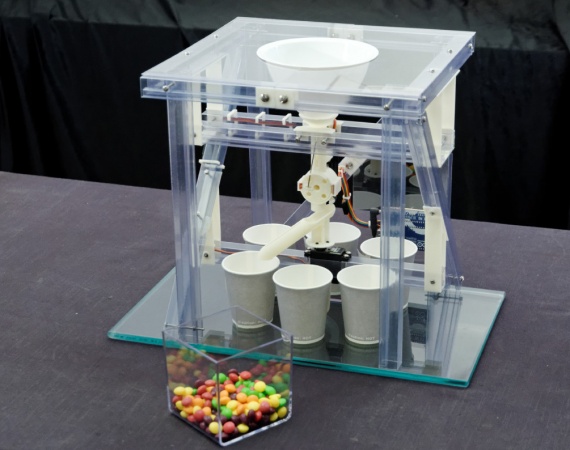
Are you interested in projects related to electronics, programming and machine building and then combining their property and recreating a whole new project, then M&M sorting machine is your type of sport. To begin with, M&M machine can be used in various type of projects, among those, Skittles M&M’s sorting machine is used for colour recognition, basically to separate varied colored skittles and M&M pieces and then to put into different individual cups.
Features
-
Supports Skittles, M&M’s, Reese’s pieces and similar sized candies
-
Sorts based on color of the piece using a RGB sensor
-
Up to six individual cup positions/colors supported
-
Hopper handles up to 500 gram / 17 oz bags
-
Preemptively releases items for optimal performance
-
Processes up to 80 pieces per minute
-
Easy maintainable C code – Arduino IDE platform based
-
Pseudo-realtime processing model with non-locking delay library
-
External terminal possible for statistics and diagnostics
-
Powered off single 5V power supply
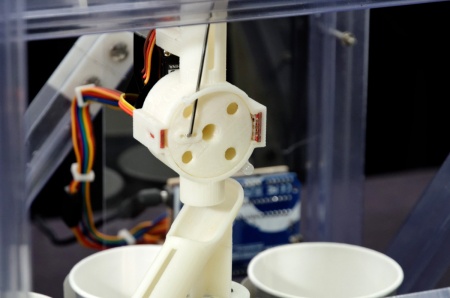
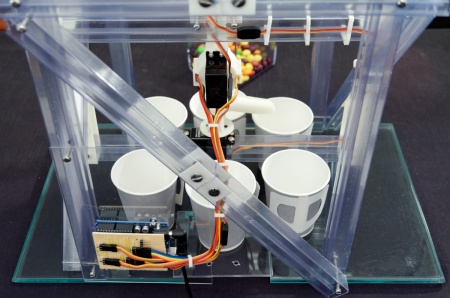
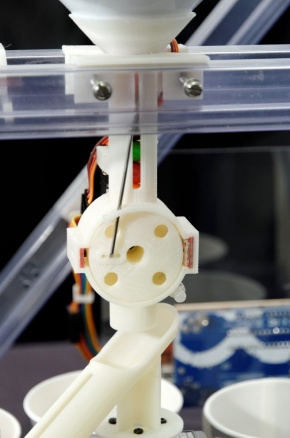
Working of the machine
Built on an ATmega328 microcontroller (Arduino Uno), RGB color sensor, IR distance sensor, two servos, plastic frame tubes and a few custom designed 3D printed parts, the automated machine can classify an entire 1.5kg/56oz bag in approx. 5 minutes. The idea of event driven finite-state machine (FSM) execution is the main force working for each process. In order to make the system responsive and allow it to run properly, the processing is working under the idea of pseudo-real time programming. The processing is given in details below
Loading pieces
The machine has total of four slots and it uses two GWS servos for sorting and loading of pieces. With the help of a variable rotation speed, the servo loads pieces into four slots in the feed wheel. If a piece struck down between loading tube and slot, the system will reverse the rotation of the feed wheel.
Analyzing color
After sorting out the pieces into their individual slots, a visual indication of the detected color is given with the help of a white LED, which illuminates the piece. Further, a distance sensor governs the feed wheel rotation which detects the slot depth change. This transition is used to change process state and start the color analysis at the right moment.
Sorting
After the identification of colour, the piece is dropped onto a 360-degree servo from the feed wheel. A feeding tube attached to it guides the piece to fall into the right cup. When all the pieces are completely sorted, the machine shuts down and start again for the next round. Any consistent data is not registered by sensor.
Possible improvements
-
A faster 360 degree rotation servo would enhance the performance of the system
-
Larger wheel to hold more pieces can be used to implement a queuing system and improve unloading speed
-
To calculate the shortest distance to the next cup, a 720 or 1080 degree rotation servo can be used
-
A vibration motor could be installed in the funnel and hopper to avoid possible clogging
-
A LCD display to show the current color distribution and other vital system information
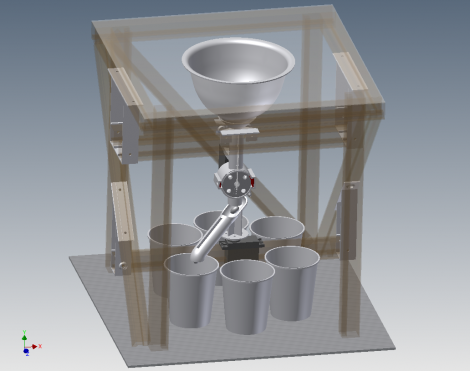
Well, items used in Skittles M&M’s sorting machine are easily available and are pocket friendly too. Further, if you are a pro in this subject, then we will not slow you down and restrain the use of M&M only for servo motor or for colour recognition. In fact, its usage are infinite and depends on your creativity, for example, zooming of a coin through a sensor faster than you can even see and by a pop up module, nudging down the correct path.
Filed Under: Reviews


Questions related to this article?
👉Ask and discuss on Electro-Tech-Online.com and EDAboard.com forums.
Tell Us What You Think!!
You must be logged in to post a comment.